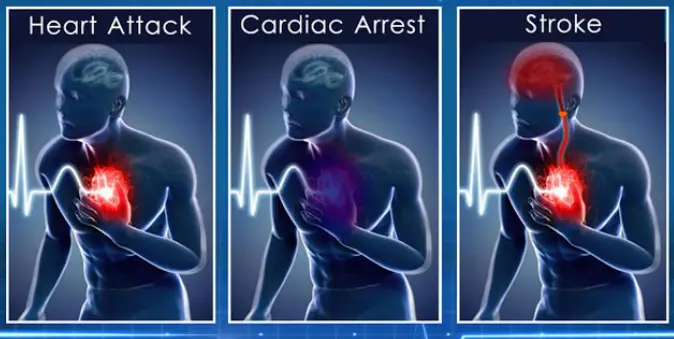Understanding the Distinctions Between Stroke and Heart Attack
- Shane Yole
- Aug 13
- 4 min read
When it comes to cardiovascular health, two serious conditions often discussed are stroke and heart attack. Though both can have life-altering outcomes, they are fundamentally different in their causes, symptoms, and treatments. Knowing these distinctions is crucial for recognizing when to seek immediate medical help.

What is a Stroke?
A stroke occurs when the blood supply to the brain is disrupted. This can happen in the following two main ways:
Ischemic Stroke: This type accounts for about 87% of all strokes. It occurs when a blood vessel supplying blood to the brain is blocked, often due to a blood clot. For example, a clot might form in the arteries due to cholesterol buildup, which can eventually lead to a stroke.
Hemorrhagic Stroke: This type occurs when a blood vessel in the brain bursts, causing bleeding either in or around the brain. Conditions like high blood pressure or brain aneurysms often lead to this. According to the CDC, about 13% of strokes are hemorrhagic.
Brain cells begin to die within minutes due to the lack of oxygen and nutrients, leading to permanent damage or death if not treated quickly.
What is a Heart Attack?
A heart attack, or myocardial infarction, happens when blood flow to a portion of the heart is blocked, usually by a blood clot. This blockage prevents oxygen-rich blood from reaching the heart muscle, resulting in damage or death to the heart tissue.
Heart attacks can be triggered by:
Coronary Artery Disease (CAD): The leading cause, where arteries become narrowed or blocked from plaque. Studies show that approximately 50% of heart attacks are linked to CAD.
Spasms of the coronary arteries: These spasms can suddenly reduce or stop blood flow to the heart.
Recognizing the symptoms of a heart attack is critical, as timely treatment can save lives.
Key Differences in Symptoms
While both strokes and heart attacks can be life-threatening, their symptoms differ considerably.
Stroke Symptoms
The symptoms of a stroke can be remembered using the acronym FAST:
Face drooping: One side of the face may droop or feel numb.
Arm weakness: One arm might feel weak or numb.
Speech difficulties: Speech may be slurred or hard to understand.
Time to call emergency services: If any of these symptoms appear, it's crucial to seek immediate help.
Additional symptoms may include sudden confusion, trouble seeing in one or both eyes, or a sudden severe headache.
Heart Attack Symptoms
Heart attack symptoms can also vary, but common signs include:
Chest pain or discomfort: This may feel like pressure, squeezing, or fullness.
Discomfort in other areas: Pain can radiate to the shoulders, neck, arms, back, teeth, or jaw.
Shortness of breath: This may occur alongside or without chest discomfort.
Other signs: Cold sweat, nausea, or lightheadedness.
It's important to note that not everyone experiences the same symptoms. Women, in particular, may show atypical signs, such as fatigue or indigestion.
Risk Factors
Both strokes and heart attacks share several risk factors, including:
High blood pressure: A major risk factor for both conditions.
High cholesterol: Elevated levels can lead to plaque buildup in arteries.
Diabetes: This condition raises the risk of heart disease and stroke by nearly twice.
Smoking: Tobacco use is a known contributor to cardiovascular diseases.
Obesity: Excess weight can lead to high blood pressure and diabetes.
Other contributing factors include a sedentary lifestyle, excessive alcohol consumption, and a family history of cardiovascular diseases.
Treatment Approaches
The treatment for stroke and heart attack varies significantly due to the nature of each condition.
Stroke Treatment
For ischemic strokes, treatment may involve:
Clot-busting drugs: These medications can dissolve clots to restore blood flow to the brain effectively. For instance, the use of tissue plasminogen activator (tPA) can significantly reduce long-term disability if administered within 3 to 4.5 hours of symptom onset.
Mechanical thrombectomy: A procedure to physically remove clots.
For hemorrhagic strokes, treatment may include:
Surgery: To repair the damaged blood vessel or alleviate pressure on the brain.
Rehabilitation is essential after a stroke to help individuals regain lost abilities and improve their quality of life.
Heart Attack Treatment
Immediate treatment for a heart attack may include:
Medications: Such as aspirin to thin the blood and clot-busting drugs to dissolve clots.
Surgical procedures: For example, angioplasty, which uses a balloon to open blocked arteries, or coronary artery bypass grafting (CABG), can restore adequate blood flow.
Long-term management usually involves lifestyle changes, ongoing medications, and participation in cardiac rehabilitation programs to support recovery.
Prevention Strategies
Preventing both strokes and heart attacks involves committing to a heart-healthy lifestyle. Here are effective strategies:
Regular exercise: Aim for at least 150 minutes of moderate aerobic activity each week, which can decrease the risk by around 30% to 40%.
Healthy diet: Focus on fruits, vegetables, whole grains, lean proteins, and healthy fats. Limiting salt, sugar, and saturated fats is vital.
Regular health check-ups: Keep track of blood pressure, cholesterol levels, and blood sugar.
Quit smoking: Seek proper support to help quit if you smoke, as this can halve your risk of heart disease.
Manage stress: Engage in relaxation techniques like yoga or deep breathing exercises.
Final Thoughts
Understanding the differences between a stroke and a heart attack can empower you to recognize symptoms and seek timely medical help. Both conditions can have serious consequences, but by staying informed and managing your health proactively, risk factors can be significantly reduced.
Ultimately, knowledge is key. Being aware of the signs and symptoms can help ensure prompt treatment and improve outcomes for you and your loved ones.










Comments